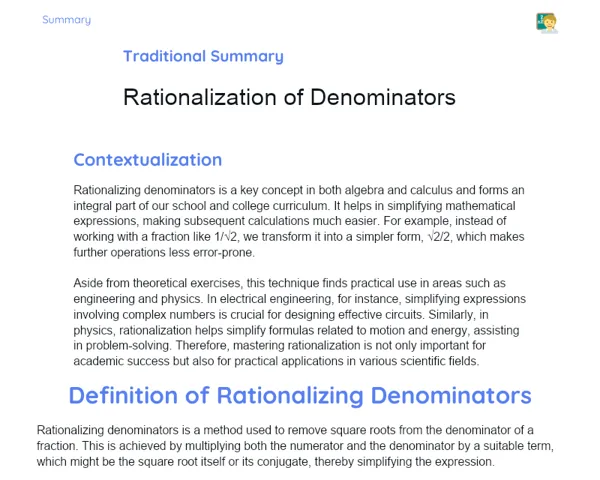Socioemotional Summary Conclusion
Goals
1. Understand what a rhombus is and identify its geometric properties, including equal sides and angles.
2. Calculate the measures of sides and angles in a rhombus using relevant formulas and mathematical concepts.
3. Solve real-life problems involving rhombuses, applying what you've learned to tackle everyday issues.
Contextualization
🔍 Did you know the rhombus isn’t just a geometric shape but also a symbol found in many aspects of our everyday lives? From road signs to jewellery and design motifs, you'll spot rhombuses everywhere! Gaining insight into their properties can enhance your mathematical understanding and help you make more informed decisions in practical situations. Are you ready to explore further? 🚀
Exercising Your Knowledge
Definition and Properties of the Rhombus
A rhombus is an intriguing geometric figure brimming with distinctive features! It’s a quadrilateral where all sides are of equal length, classifying it as a special type of parallelogram. Its unique properties play a significant role in solving both practical and theoretical problems, making the rhombus a vital figure in various mathematical contexts.
-
The sides of the rhombus are congruent, meaning they’re all the same length. 🎲
-
The opposite angles in a rhombus are congruent, indicating they measure the same. 📐
-
The diagonals of a rhombus meet at right angles (90 degrees) and bisect each other, dividing them in half. 🔍
Calculating Measurements in the Rhombus
Calculating areas and perimeters in a rhombus is a valuable skill that employs specific mathematical formulas. These are essential for tackling everyday challenges and various geometric situations.
-
Area of the rhombus: Calculate it using the formula (Long diagonal * Short diagonal) / 2. This determines the shape's internal space. 🧮
-
Perimeter of the rhombus: Given by the total of all sides. Since all sides are equal, the formula is 4 * side. This is handy for measuring the outline of the shape. 📏
-
Use in Practical Problems: Being able to calculate these measures helps solve real-world issues, like figuring out the materials needed for fencing a rhombus-shaped area.
Analogies and Comparisons with Other Shapes
Understanding the similarities and differences between the rhombus and other geometric figures, like the square, can deepen your grasp of geometric properties. This comparison helps clarify where and how to apply rhombus knowledge in various contexts.
-
Similarities with the Square: Both shapes have all sides equal, but their internal angles differ. In a rhombus, the angles can change, whereas in a square, all are 90 degrees. 📊
-
Constructive Differences: The square is a specific type of rhombus that has right angles. This distinction is crucial for correctly identifying the shapes and their unique properties. ✏️
-
Application in Tests and Demonstrations: Understanding these similarities and differences aids in tackling math tests and demos, facilitating effective argumentation and problem-solving.
Key Terms
-
Rhombus: A quadrilateral with all sides of equal length.
-
Diagonals: Line segments connecting opposite vertices of the rhombus, intersecting at right angles.
-
Congruence: The property of sides and angles being equal in measure.
-
Area: Measure of the internal space of the rhombus, calculated using (Long diagonal * Short diagonal) / 2.
-
Perimeter: The sum of the lengths of all sides of the rhombus, calculated as 4 * side.
For Reflection
-
How can you use the properties of a rhombus to address a problem in your daily life?
-
How did group work influence your understanding and application of the formulas for area and perimeter of the rhombus?
-
What was the most significant emotional challenge you faced during this lesson, and how did you handle it? Did you use any techniques to help you focus or calm down?
Important Conclusions
-
✅ We’ve learned that a rhombus is a quadrilateral with all sides equal and have identified its key properties, such as congruent angles and diagonals that intersect at right angles.
-
🧮 We’ve gained skills to calculate side and angle measures in a rhombus using specific formulas for area and perimeter.
-
🔍 We’ve tackled practical problems involving rhombuses, applying our knowledge to identify and resolve everyday challenges.
Impacts on Society
Rhombuses appear in various contexts of our lives, from road signs to jewellery, design patterns, and even architecture. Understanding their properties not only expands our mathematical knowledge but also helps us make more informed decisions. For instance, knowing how to calculate a rhombus's area can be crucial for determining the materials required for a design project.
Emotionally, working with geometric shapes like the rhombus can enhance your ability to approach complex problems methodically. Practising solving mathematical questions and sharing solutions in groups fosters communication and empathy, promoting a collaborative and respectful environment. Plus, the knowledge you acquire can boost your confidence in both academic and real-world scenarios.
Dealing with Emotions
To manage your emotions while studying rhombuses and their applications, I suggest trying the following exercise based on the RULER method. First, Recognize your feelings when faced with a math problem: do you feel anxious, frustrated, or challenged? Second, Understand what’s causing those feelings: is it the problem’s complexity or the pressure to arrive at a solution quickly? Third, Label your emotions accurately: are you feeling nervous, confused, or determined? Fourth, Express those feelings appropriately: discuss your difficulties with a teacher or peer. Lastly, Regulate your feelings to overcome the challenge: practise deep breathing to relax and approach each problem step by step calmly.
Study Tips
-
📝 Practice regularly: Dedicate time each week to work on rhombus problems. This will solidify your understanding of properties and formulas.
-
👥 Form study groups: Collaborating with friends on math problems can help you explore different approaches and solutions.
-
📚 Use online resources: Many tutorials, videos, and exercises are available online to enhance your understanding and practice of studying rhombuses.



